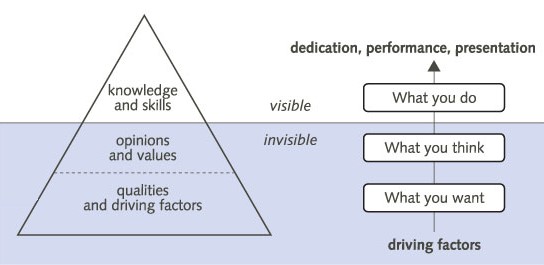Self-reflection on your role as supervisor
Iceberg Model of McClelland
The Iceberg Model of McClelland distinguishes two regions: the visible tip of the iceberg and the submerged part of the iceberg, which is invisible but it is the biggest part of the iceberg.
The characteristics of which you are most conscious are your behavior, knowledge and skills, depicted as the tip of the iceberg. Skills represent what you can do and knowledge is what you know, including your experience of things and situations.
Below the water surface there are four layers that are often unspoken, invisible and unconsciously present. These are our beliefs, values, qualities and drivers. They represent what you are thinking about yourself, others and your role and want you want for yourself and others, what is important to you. These factors (such as norms and values) can influence our visible behavior and knowledge: they can either work reinforcing or obstructing. Especially when your behavior is not compatible with what you believe in or what you value, you may feel frustrated or inadequate in your role.
“Everything you (don’t) do (visible behavior) is influenced by what is happening below the water surface (thoughts, feelings, wishes). If you want to become more effective as a professional, you need to reflect and to become aware of what is happening below the water surface and detect frictions above and below the water surface .”
Following questionnaire can help you in this reflection process as you can become more aware of what you do, think and want in your role as supervisor.
The supervisory checklist
The supervisory checklist is a tool for self-assessment and can help you to reflect on how you typically tend to supervise your PhD candidates and might stimulate you to enhance certain aspects of your supervision.
